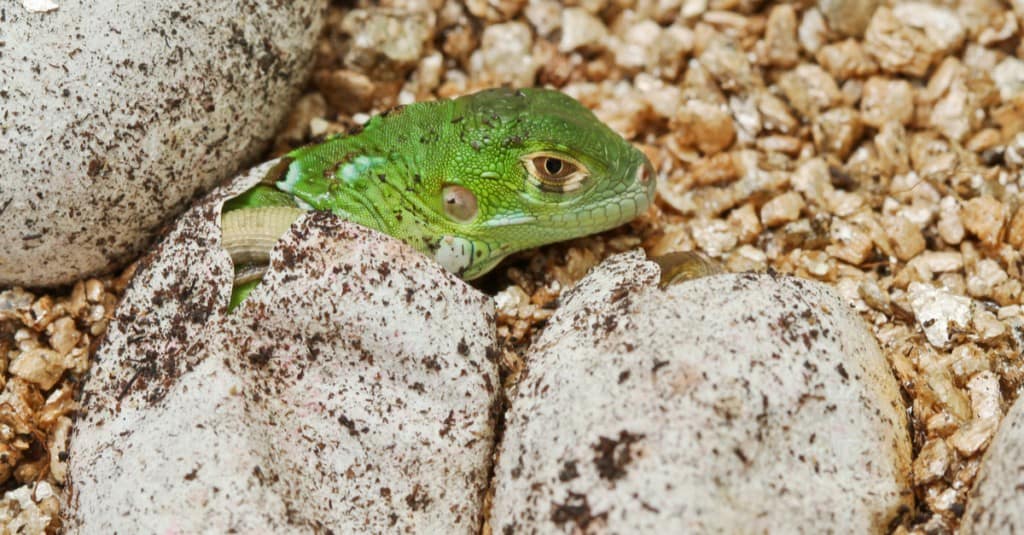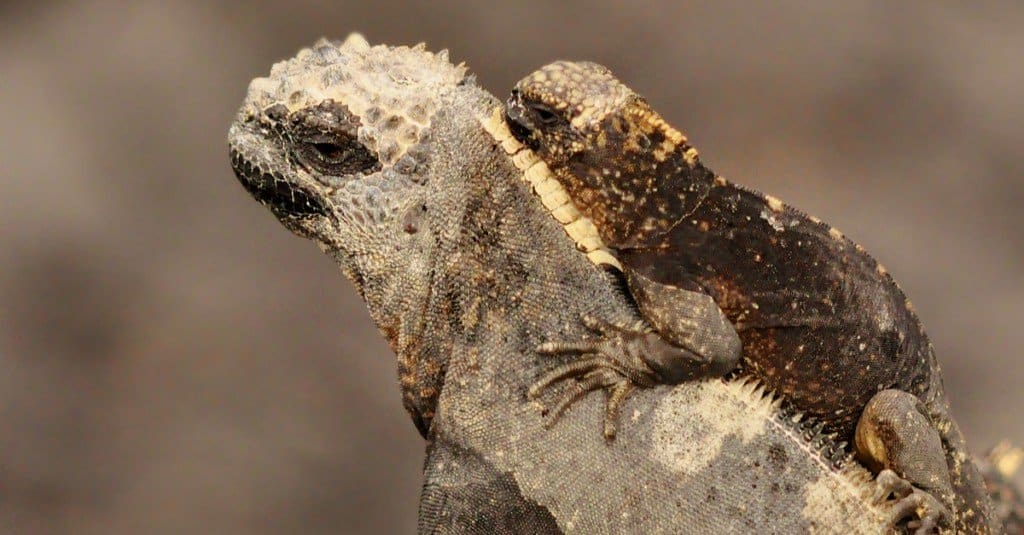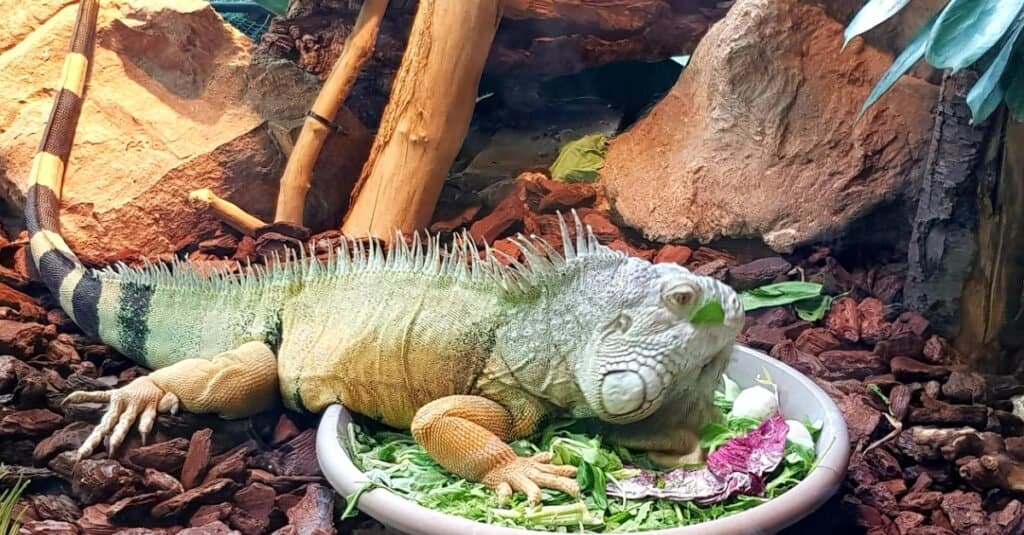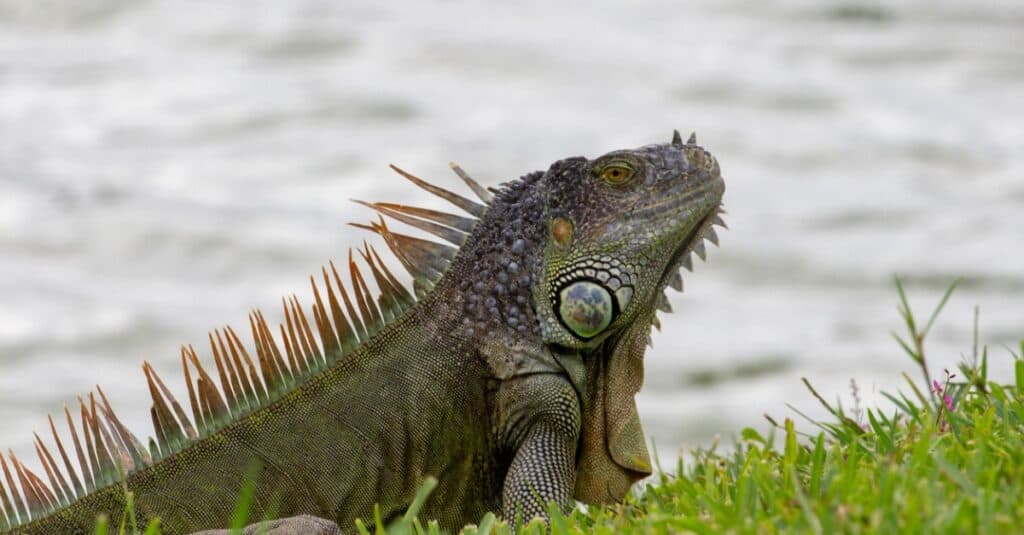Even though they start out very small as babies, iguanas are among the largest lizards in the world. Whether you’re thinking of adopting a pet iguana of your own or are simply captivated by these majestic reptiles, it’s a good idea to understand how big iguanas get by the time they reach their full adult size.
Read on as we take an in-depth look at the sizes of various species, from the modest desert iguana and Yucatan spiny-tailed iguana all the way up to the absolutely massive green iguana dominating much of South and Central America. In addition, we’ll cover what kinds of factors can affect and ultimately determine an iguana’s size and growth rate.
How Big Are Baby Iguanas?

As hatchlings, most iguanas are only a few inches long.
©bluedog studio/Shutterstock.com
Regardless of their species, all baby iguanas begin life as tiny hatchlings. Most iguanas are only 2 to 4 inches long and weigh around 0.2 to 0.3 pounds upon hatching. As they age and become juveniles, though, they explode in size extremely quickly. They are actually some of the fastest-growing reptiles on the planet! In fact, many species are born with fully-formed teeth that are ready to start tearing apart plants and insects immediately after the lizard has emerged from its egg.
The majority of iguana species are considered babies or juveniles until they are roughly 12 to 18 months old. It is common for them to triple or quadruple both their weight and length within just a few short months. In addition, many larger species like green iguanas and spiny-tailed iguanas end up putting on anywhere from 2 to 5 pounds within their first year!
Sadly, this rapid growth rate often results in many pet iguanas being abandoned or rehomed within the first year of their lives. Unfortunately, most novice reptile hobbyists don’t expect such tiny lizards to become 3-to-5-foot long behemoths in such a short period of time.
However, not all species grow up to become giants! Next, let’s take a look at how large various species become as adults and beyond. Even though most individuals reach adulthood by the time they’re roughly one year old, many don’t completely stop growing until they are around 2 to 4 years old.
How Big Do Iguanas Get?

The largest iguana species can reach up to 6 feet long.
©LouieLea/Shutterstock.com
Depending on their species, iguanas can reach anywhere from 7 inches to a whopping 6 feet long and weigh between 0.5 pounds and 15 pounds. This is a wide range, but there are more than 40 unique species of iguanid lizards, and they are very diverse as far as size goes.
Some of the smaller species, like the desert iguana, Fiji banded iguana, and Yucatan spiny-tailed iguana only reach a maximum size of about 7 to 12 inches long and less than half a pound in weight. These little lizards start out small and grow fairly slowly compared to larger species like chuckwallas and green iguanas.
On the larger end of the spectrum, we have species such as the marine iguana, Mexican spiny-tailed iguana, and Cuban rock iguana. These lizards commonly reach 3 to 5+ feet in length and can weigh anywhere from 5 to 15+ pounds! They start out small and experience a rapid growth period until they are around a year old. After this, though, they will continue to grow, albeit slowly, well into adulthood. It is common for green iguanas, for example, to experience growth spurts until they are 2 to 3 years old.
What Factors Influence an Iguana’s Size?

For an iguana to reach its maximum possible size, it should be fed a healthy, nutritious diet.
©iStock.com/Suzana Dreno
The main determinants of an iguana’s maximum possible size are its species and genetic makeup. For example, a Yucatan spiny-tailed iguana will never reach the same size as a marine iguana. This is because the two are very different species with different maximum sizes that have been influenced by their own unique genetics, environments, and dietary needs over the course of thousands of years of evolution.
However, many factors can either encourage or discourage an individual to actually reach its full size, including the following:
- Whether they are wild or captive-raised
- Quality of their diet/nutrition
- Enclosure size (if captive-raised)
- Proper husbandry and enclosure setup (if captive-raised)
- Illnesses or injuries
As you might imagine, this means captive iguanas are almost always larger and heavier than their wild counterparts. Since they live in more controlled environments and don’t have to deal with predators, food scarcity, and temperature fluctuations, iggies kept as pets or otherwise in captivity (such as at zoos or wildlife conservation facilities) are able to reach their maximum size much easier.
Are Males Larger Than Females?

Male green iguanas have very large dewlaps, jowls, and spikes and are usually larger overall than females.
©iStock.com/Stacie Acevedo
Most iguana species display slight sexual dimorphism. This simply means males and females within the same species have unique differences, like length, weight, and color. Males also usually have larger spikes down their spines and tails, larger dewlaps, and larger, heavier jowls.
In general, males are both larger and longer than females, regardless of their species. For example, male green iguanas commonly reach sizes of 5+ feet long and 15+ pounds. However, females are much smaller at only 3 to 4 feet long and 5 to 10 pounds on average.
This isn’t necessarily true 100% of the time, though, as it is merely a general estimate. All species can display some slight variations when it comes to the size differences between the sexes. For instance, a female green iguana can reach 10+ pounds, but they’re usually smaller.
The photo featured at the top of this post is © LouieLea/Shutterstock.com
Thank you for reading! Have some feedback for us? Contact the AZ Animals editorial team.






